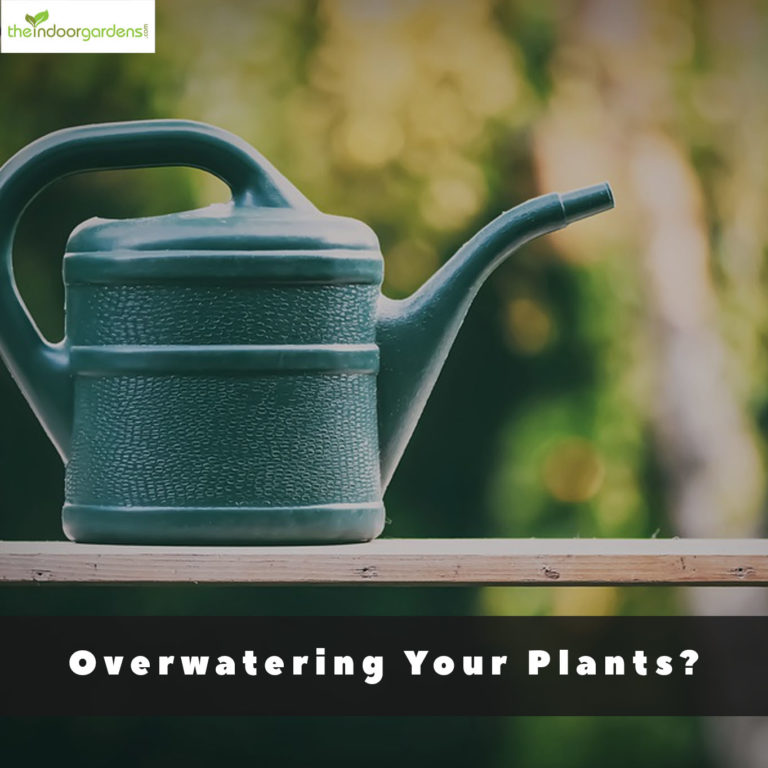Everyone knows that water is an important resource for plants and too little can be harmful. What many people don’t realize though is that too much water can also be harmful to plants. In this article, we’ll look at water’s role in plant health, specifically how too much water effects it. We’ll look at why overwater plants is bad, what the signs of overwatering plants are, and what to do if you overwater your plant.
Before we jump into it know that most overwatering issues happen to indoor plants or those grown in containers. In natural soil, water has more places to move to, and therefore won’t sit around as long. Do take note though that even outdoors plants be suffer from overwatering, it just generally takes a lot more.
Overwatering Plants – What Harm Does it Do?
The first thing to look at is why overwater plants is bad. There are too main reasons, lack of oxygen and root rot.
Like us humans, plant’s do need oxygen to survive. While many know that plants require CO2, plants also require oxygen which is absorbed by the roots of a plant. Soil naturally has lots of small air pockets, and the roots go out and grab this oxygen trapped in the soil. When you water a plant, it reduces the amount of oxygen and makes it harder for the plant to get the amount that it needs. Prolonged depravation of oxygen will kill a plant.
The other issue is root rot. Root rot is exactly as it sounds, it’s your roots rotting usually cause by over saturated soil. When water sits in your soil for too long it lead to the development of fungi which can attack your plants roots. Once this starts, it’s very difficult to stop, and often times means the end of the plant.
Signs of Overwatering Plants
With the dangers of overwatering clear it’s also important to look for signs that you might be overwatering your plants. In many cases, you can reverse the harm done by simply being a bit more careful with how much you water.
Brown Or Yellowing Leaves: Probably the most noticeable issue is overwatering will often lead to discolored leaves. Take note though, this is often a symptom of under watering as well. The key difference is an overwatered plants leaves will feel soft or limp while an under watered one’s will often feel crumbly and dry.
Constantly Damp Soil: Most plants don’t like their soil to be constantly wet and if it is that can spell trouble. It’s a good idea to check the soil every few days to make sure it’s dry out properly. If not, it means your container has a drainage problem which can lead to overwatering problems.
Blisters: As the plant’s cells become over-saturated with water they will eventually burst. This can lead to lesions or blisters on your plant. Look for dark or white scar-tissue on your plant, as well as indentations on the leaves.
Stunted Growth: Lastly, a plant that is inexplicably not growing, or doing so slowly, may be suffering from too much water. If everything else is okay on the plant, but it’s still not growing try holding back a bit on the amount you water it to see if that makes a difference.
What To Do If You Overwater a Plant
While there’s no guarantees, it is possible to save a plant that has been overwatered. In many cases, this will be based on how long it’s gone with excess water. The sooner your catch and correct the issues the more likely you are to save the plant.
First off, it’s important to correct any watering issues. You’ll want to get on a schedule that provides the correct amount of water, and maintain it. In the meantime, give the plant some rest and let its soil dry out. During this time, you might want to move the plant to a shady spot to prevent burning out the leaves.
Next, examine your plant’s container and make sure it has proper drainage. Most plant containers should have drainage holes to allow excess water to flow out of the soil. If your container doesn’t have these, or has too few, it’s never a bad idea to add a few. Also, keep in mind the material your container is made out of. Materials like clay will naturally whisk water away from the soil and therefore make it more difficult to overwater.
Lastly, you’ll want to clean the plant and remove any dead or dying leaves. In extreme cases, you may also want to re-pot the plant into fresh soil. This will give the plant a fresh home with the necessary nutrients to thrive. When doing this, look at the roots and determine if your plant is suffering from root rot. If so, remove the affected roots and consider treating the rest with special anti-fungal products to help prevent the spread of the fungus.
Overwatering Plants
Overwatering plants is a big problem, and one that all gardeners should be aware of. Hopefully, after reading the above you’re prepared with the knowledge of how to deal with overwatered plants. As always, feel free to reach out to us here or through our social media channels if you have any questions!







